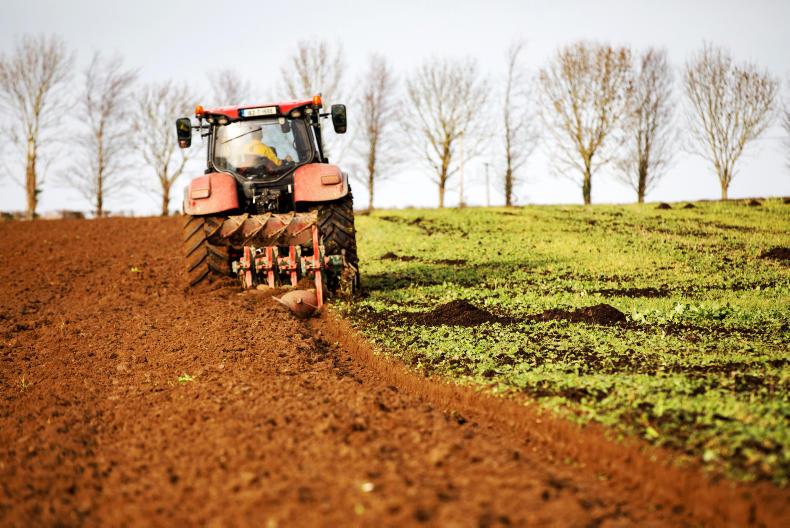As the weight of farm machinery continues to increase, the pressure on the soil structure of headlands also increases. It's important that these heavier machines use the most efficient headland turning style to limit overlapping and tracking of soil.
Brendan Bourke of Teagasc analysed headland turning on 35 farms, looking at range of factors including overlaps, efficiency, shape of the ark, weight and width of the tractor, tyre pressure and many more. He found that there were five main turning methods;
Three point turn.Loop.Skip pass.Long loop.Four point turn.
Three point turn

The most popular turning method is the three point turn. Here the tractor drives out on to the headland and positions itself towards the hedge. The driver then reverses in a parallel manner along the headland before driving forward into the main body of the field again. See figure 1.
The loop
This method is fast and efficient and is commonly used with trailed implements. The tractor drives out of the main field area and preforms a continuous loop in the headland before driving back into the main field area. This method requires a large headland.
Skip pass
The skip pass is typically GPS-assisted and involves the tractor skipping two to three passes. The tractor dives out of the main field area on to the headland, skips a number of passes then joins back into the main body. There is no reversing needed.
Long loop
This turning method is commonly used with a trailed plough or trailed drill. Here, the tractor drives on to the headland from the main field area and proceeds to drives down the headland. It then preforms a loop before making its way back up the headland and turns back into the main field area. The tractor will often make the figure of eight shape when preforming this turn.
Four point turn
This is similar to the three point turn but once the tractor is lined up with the main field area, the operator reverses then drives forward again. This ensures that the tractor is in line with the direction of travel in the main field area. This method is used where headland turns are tight and can be used with GPS guidance.

Brendan Burke from Teagasc speaking at the Rooster festival held in Oak Park, last year. Photo:Barry
Results
Brendan found that each turning style results in varying levels headland traffic. The four point turn had the highest tracked area while the skip pass had the lowest.
The loop turn had the lowest levels of area tracked twice, while the three point turn had the highest.
The loop turn also had the lowest area which was tracked three times, while the four point turn had the highest.
As the weight of farm machinery continues to increase, the pressure on the soil structure of headlands also increases. It's important that these heavier machines use the most efficient headland turning style to limit overlapping and tracking of soil.
Brendan Bourke of Teagasc analysed headland turning on 35 farms, looking at range of factors including overlaps, efficiency, shape of the ark, weight and width of the tractor, tyre pressure and many more. He found that there were five main turning methods;
Three point turn.Loop.Skip pass.Long loop.Four point turn.
Three point turn

The most popular turning method is the three point turn. Here the tractor drives out on to the headland and positions itself towards the hedge. The driver then reverses in a parallel manner along the headland before driving forward into the main body of the field again. See figure 1.
The loop
This method is fast and efficient and is commonly used with trailed implements. The tractor drives out of the main field area and preforms a continuous loop in the headland before driving back into the main field area. This method requires a large headland.
Skip pass
The skip pass is typically GPS-assisted and involves the tractor skipping two to three passes. The tractor dives out of the main field area on to the headland, skips a number of passes then joins back into the main body. There is no reversing needed.
Long loop
This turning method is commonly used with a trailed plough or trailed drill. Here, the tractor drives on to the headland from the main field area and proceeds to drives down the headland. It then preforms a loop before making its way back up the headland and turns back into the main field area. The tractor will often make the figure of eight shape when preforming this turn.
Four point turn
This is similar to the three point turn but once the tractor is lined up with the main field area, the operator reverses then drives forward again. This ensures that the tractor is in line with the direction of travel in the main field area. This method is used where headland turns are tight and can be used with GPS guidance.

Brendan Burke from Teagasc speaking at the Rooster festival held in Oak Park, last year. Photo:Barry
Results
Brendan found that each turning style results in varying levels headland traffic. The four point turn had the highest tracked area while the skip pass had the lowest.
The loop turn had the lowest levels of area tracked twice, while the three point turn had the highest.
The loop turn also had the lowest area which was tracked three times, while the four point turn had the highest.








 This is a subscriber-only article
This is a subscriber-only article









SHARING OPTIONS: